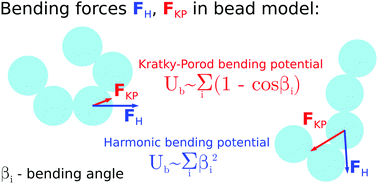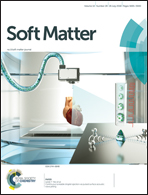Different bending models predict different dynamics of sedimenting elastic trumbbells†
Abstract
The main goal of this paper is to examine theoretically and numerically the impact of a chosen bending model on the dynamics of elastic filaments settling in a viscous fluid under gravity at low-Reynolds-number. We use the bead-spring approximation of a filament and the Rotne–Prager mobility matrix to describe hydrodynamic interactions between the beads. We analyze the dynamics of trumbbells, for which bending angles are typically larger than for thin and long filaments. Each trumbbell is made of three beads connected by springs and it exhibits a bending resistance, described by the harmonic or – alternatively – by the ‘cosine’ (also called the Kratky–Porod) bending models, both often used in the literature. Using the harmonic bending potential, and coupling it to the spring potential by the Young's modulus, we find simple benchmark solutions: stable stationary configurations of a single elastic trumbbell and attraction of two elastic trumbbells towards a periodic long-lasting orbit. As the most significant result of this paper, we show that for very elastic trumbbells at the same initial conditions, the Kratky–Porod bending potential can lead to qualitatively and quantitatively different spurious dynamics, with artificially large bending angles and unrealistic shapes. We point out that for the bead models of an elastic filament, the range of applicability of the Kratky–Porod model might not go beyond bending angles smaller than π/2 for touching beads and beyond an even much lower value for beads well-separated from each other. The existence of stable stationary configurations of elastic trumbbells and a family of periodic oscillations of two elastic trumbbells are very important findings on their own.



 Please wait while we load your content...
Please wait while we load your content...